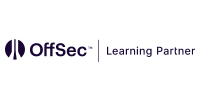Opinie uczestników szkolenia (2)
2024-12-02 |  | Grzegorz
| Grzegorz
Opinia dotycząca trenera: Wiedza trenera na wysokim poziomie.
Ogólna ocena szkolenia: bardzo dobry.
2024-12-02 |  | Sebastian
| Sebastian
Opinia dotycząca trenera: Przygotowany, kompetentny.
Ogólna ocena szkolenia: Bardzo dobra.
Dodatkowe informacje
| Wymagania wstępne | Penetration Testing with Kali Linux is a foundational course but still requires learners to have certain knowledge before attending the online class. A solid understanding of TCP/IP, networking, and reasonable Linux skills are required. Familiarity with Bash scripting along with basic Perl or Python is considered a plus. |
|---|---|
| Poziom trudności | |
| Czas trwania | 5 dni |
| Certyfikat | The participants will obtain certificates signed by Compendium CE (course completion). The PEN-200 course and online lab prepares you for the OSCP+ penetration testing certification. Learn more about the OSCP+ exam https://help.offsec.com/hc/en-us/articles/360040165632-OSCP-Exam-Guide Each participant in an authorized OffSec PEN-200 training held at Compendium CE receives a Learn One” license, which includes, among other benefits, a free OSCP+ exam voucher. |
| Prowadzący | Authorized OffSec Trainer |
| Informacje dodatkowe | The course includes a license “Learn One” The license includes:
|
Najbliższe szkolenia OffSec
-
2026-01-12 | 5 dni | Kraków / Wirtualna sala
OffSec PEN-200 Penetration Testing with Kali Linux
szkolenie dostępne w wersji stacjonarnej we wskazanej lokalizacji lub w trybie zdalnym, w zależności od preferencji uczestnika: HYBRID -
2026-01-12 | 5 dni | Warszawa / Wirtualna sala
OffSec PEN-200 Penetration Testing with Kali Linux
szkolenie dostępne w wersji stacjonarnej we wskazanej lokalizacji lub w trybie zdalnym, w zależności od preferencji uczestnika: HYBRID -
2026-02-02 | 5 dni | Kraków / Wirtualna sala
OffSec PEN-200 Penetration Testing with Kali Linux
szkolenie dostępne w wersji stacjonarnej we wskazanej lokalizacji lub w trybie zdalnym, w zależności od preferencji uczestnika: HYBRID -
2026-02-02 | 5 dni | Warszawa / Wirtualna sala
OffSec PEN-200 Penetration Testing with Kali Linux
szkolenie dostępne w wersji stacjonarnej we wskazanej lokalizacji lub w trybie zdalnym, w zależności od preferencji uczestnika: HYBRID -
2026-03-02 | 5 dni | Kraków / Wirtualna sala
OffSec PEN-200 Penetration Testing with Kali Linux
szkolenie dostępne w wersji stacjonarnej we wskazanej lokalizacji lub w trybie zdalnym, w zależności od preferencji uczestnika: HYBRID -
2026-03-02 | 5 dni | Warszawa / Wirtualna sala
OffSec PEN-200 Penetration Testing with Kali Linux
szkolenie dostępne w wersji stacjonarnej we wskazanej lokalizacji lub w trybie zdalnym, w zależności od preferencji uczestnika: HYBRID -
2026-04-13 | 5 dni | Kraków / Wirtualna sala
OffSec PEN-200 Penetration Testing with Kali Linux
szkolenie dostępne w wersji stacjonarnej we wskazanej lokalizacji lub w trybie zdalnym, w zależności od preferencji uczestnika: HYBRID -
2026-04-13 | 5 dni | Warszawa / Wirtualna sala
OffSec PEN-200 Penetration Testing with Kali Linux
szkolenie dostępne w wersji stacjonarnej we wskazanej lokalizacji lub w trybie zdalnym, w zależności od preferencji uczestnika: HYBRID -
2026-05-04 | 5 dni | Kraków / Wirtualna sala
OffSec PEN-200 Penetration Testing with Kali Linux
szkolenie dostępne w wersji stacjonarnej we wskazanej lokalizacji lub w trybie zdalnym, w zależności od preferencji uczestnika: HYBRID -
2026-05-04 | 5 dni | Warszawa / Wirtualna sala
OffSec PEN-200 Penetration Testing with Kali Linux
szkolenie dostępne w wersji stacjonarnej we wskazanej lokalizacji lub w trybie zdalnym, w zależności od preferencji uczestnika: HYBRID


